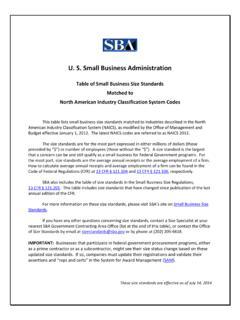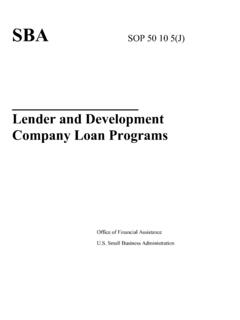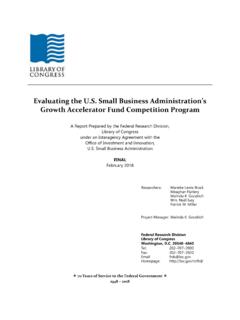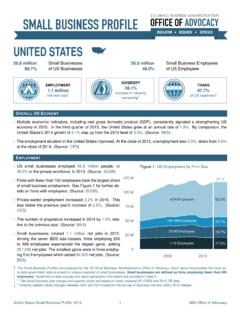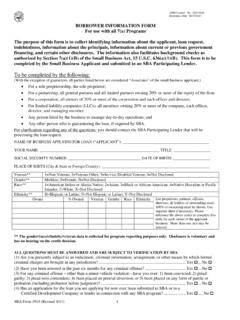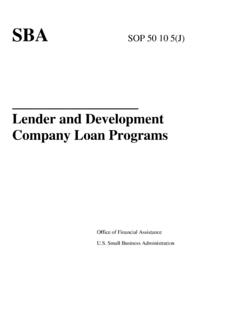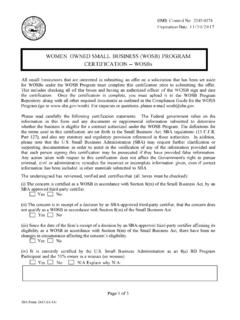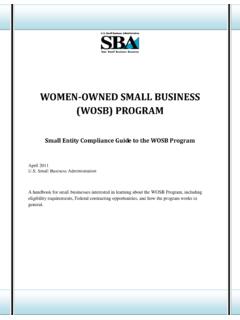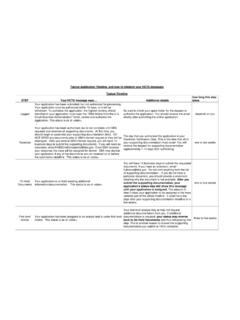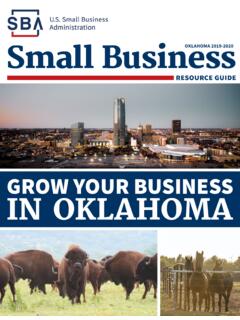Transcription of Paycheck Protection Program (PPP) Loans FAQ
1 As of January 29, 2021 FAQs 1 53 are in the process of being revised and do not yet reflect changes made by the Economic Aid to Hard-Hit Small Businesses, Nonprofits, and Venues Act enacted on December 27, 2020. 1 Paycheck Protection Program Loans Frequently Asked Questions (FAQs) The Small Business Administration (SBA), in consultation with the Department of the Treasury, intends to provide timely additional guidance to address borrower and lender questions concerning the implementation of the Paycheck Protection Program (PPP), established by section 1102 of the Coronavirus Aid, Relief, and Economic Security Act (CARES Act or the Act). This document will be updated on a regular basis. Borrowers and lenders may rely on the guidance provided in this document as SBA s interpretation of the CARES Act and of the Paycheck Protection Program Interim Final Rules ( PPP Interim Final Rules ) (link). The government will not challenge lender PPP actions that conform to this guidance,1 and to the PPP Interim Final Rules and any subsequent rulemaking in effect at the time.
2 1. Question: Paragraph of the PPP Interim Final Rule states that lenders must [c]onfirm the dollar amount of average monthly payroll costs for the preceding calendar year by reviewing the payroll documentation submitted with the borrower s application. Does that require the lender to replicate every borrower s calculations? Answer: No. Providing an accurate calculation of payroll costs is the responsibility of the borrower, and the borrower attests to the accuracy of those calculations on the Borrower Application Form. Lenders are expected to perform a good faith review, in a reasonable time, of the borrower s calculations and supporting documents concerning average monthly payroll cost. For example, minimal review of calculations based on a payroll report by a recognized third-party payroll processor would be reasonable. In addition, as the PPP Interim Final Rule indicates, lenders may rely on borrower representations, including with respect to amounts required to be excluded from payroll costs.
3 If the lender identifies errors in the borrower s calculation or material lack of substantiation in the borrower s supporting documents, the lender should work with the borrower to remedy the 2. Question: Are small business concerns (as defined in section 3 of the Small Business Act, 15 632) required to have 500 or fewer employees to be eligible borrowers in the PPP? 1 This document does not carry the force and effect of law independent of the statute and regulations on which it is based. 2 Question 1 published April 3, 2020. As of January 29, 2021 FAQs 1 53 are in the process of being revised and do not yet reflect changes made by the Economic Aid to Hard-Hit Small Businesses, Nonprofits, and Venues Act enacted on December 27, 2020. 2 Answer: No. Small business concerns can be eligible borrowers even if they have more than 500 employees, as long as they satisfy the existing statutory and regulatory definition of a small business concern under section 3 of the Small Business Act, 15 632.
4 A business can qualify if it meets the SBA employee-based or revenue-based size standard corresponding to its primary industry. Go to for the industry size standards. Additionally, a business can qualify for the Paycheck Protection Program as a small business concern if it met both tests in SBA s alternative size standard as of March 27, 2020: ( 1) maximum tangible net worth of the business is not more than $15 million; and (2) the average net income after Federal income taxes (excluding any carry-over losses) of the business for the two full fiscal years before the date of the application is not more than $5 million. A business that qualifies as a small business concern under section 3 of the Small Business Act, 15 632, may truthfully attest to its eligibility for PPP Loans on the Borrower Application Form, unless otherwise ineligible. 3. Question: Does my business have to qualify as a small business concern (as defined in section 3 of the Small Business Act, 15 632) in order to participate in the PPP?
5 Answer: No. In addition to small business concerns, a business is eligible for a PPP loan if the business has 500 or fewer employees whose principal place of residence is in the United States, or the business meets the SBA employee-based size standards for the industry in which it operates (if applicable). Similarly, PPP Loans are also available for qualifying tax-exempt nonprofit organizations described in section 501(c)(3) of the Internal Revenue Code (IRC), tax-exempt veterans organization described in section 501(c)(19) of the IRC, and Tribal business concerns described in section 31(b)(2)(C) of the Small Business Act that have 500 or fewer employees whose principal place of residence is in the United States, or meet the SBA employee-based size standards for the industry in which they operate. 4. Question: Are lenders required to make an independent determination regarding applicability of affiliation rules under 13 (f) to borrowers?
6 Answer: No. It is the responsibility of the borrower to determine which entities (if any) are its affiliates and determine the employee headcount of the borrower and its affiliates. Lenders are permitted to rely on borrowers certifications. 5. Question: Are borrowers required to apply SBA s affiliation rules under 13 (f)? As of January 29, 2021 FAQs 1 53 are in the process of being revised and do not yet reflect changes made by the Economic Aid to Hard-Hit Small Businesses, Nonprofits, and Venues Act enacted on December 27, 2020. 3 Answer: Yes. Borrowers must apply the affiliation rules set forth in SBA s Interim Final Rule on Affiliation. A borrower must certify on the Borrower Application Form that the borrower is eligible to receive a PPP loan, and that certification means that the borrower is a small business concern as defined in section 3 of the Small Business Act (15 632), meets the applicable SBA employee-based or revenue-based size standard, or meets the tests in SBA s alternative size standard, after applying the affiliation rules, if applicable.
7 SBA s existing affiliation exclusions apply to the PPP, including, for example the exclusions under 13 CFR (b)(2). 6. Question: The affiliation rule based on ownership (13 (f)(1)) states that SBA will deem a minority shareholder in a business to control the business if the shareholder has the right to prevent a quorum or otherwise block action by the board of directors or shareholders . If a minority shareholder irrevocably gives up those rights , is it still considered to be an affiliate of the business? Answer: No. If a minority shareholder in a business irrevocably waives or relinquishes any existing rights specified in 13 (f)(1), the minority shareholder would no longer be an affiliate of the business (assuming no other relationship that triggers the affiliation rules). 7. Question: The CARES Act excludes from the definition of payroll costs any employee compensation in excess of an annual salary of $100,000.
8 Does that exclusion apply to all employee benefits of monetary value? Answer: No. The exclusion of compensation in excess of $100,000 annually applies only to cash compensation, not to non-cash benefits, including: employer contributions to defined-benefit or defined-contribution retirement plans; payment for the provision of employee benefits consisting of group health care coverage, including insurance premiums; and payment of state and local taxes assessed on compensation of employees. 8. Question: Do PPP Loans cover paid sick leave? Answer: Yes. PPP Loans covers payroll costs, including costs for employee vacation, parental, family, medical, and sick leave. However, the CARES Act excludes qualified sick and family leave wages for which a credit is allowed under sections 7001 and 7003 of the Families First Coronavirus Response Act (Public Law 116 127). Learn more about the Paid Sick Leave Refundable Credit here.
9 9. Question: My small business is a seasonal business whose activity increases from April to June. Considering activity from that period would be a more accurate reflection of my As of January 29, 2021 FAQs 1 53 are in the process of being revised and do not yet reflect changes made by the Economic Aid to Hard-Hit Small Businesses, Nonprofits, and Venues Act enacted on December 27, 2020. 4 business s operations. However, my small business was not fully ramped up on February 15, 2020. Am I still eligible? Answer: In evaluating a borrower s eligibility, a lender may consider whether a seasonal borrower was in operation on February 15, 2020 or for an 8-week period between February 15, 2019 and June 30, 2019. 10. Question: What if an eligible borrower contracts with a third-party payer such as a payroll provider or a Professional Employer Organization (PEO) to process payroll and report payroll taxes?
10 Answer: SBA recognizes that eligible borrowers that use PEOs or similar payroll providers are required under some state registration laws to report wage and other data on the Employer Identification Number (EIN) of the PEO or other payroll provider. In these cases, payroll documentation provided by the payroll provider that indicates the amount of wages and payroll taxes reported to the IRS by the payroll provider for the borrower s employees will be considered acceptable PPP loan payroll documentation. Relevant information from a Schedule R (Form 941), Allocation Schedule for Aggregate Form 941 Filers, attached to the PEO s or other payroll provider s Form 941, Employer s Quarterly Federal Tax Return, should be used if it is available; otherwise, the eligible borrower should obtain a statement from the payroll provider documenting the amount of wages and payroll taxes. In addition, employees of the eligible borrower will not be considered employees of the eligible borrower s payroll provider or PEO.
